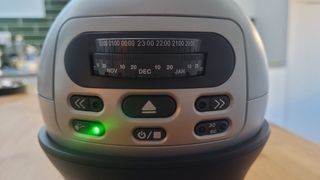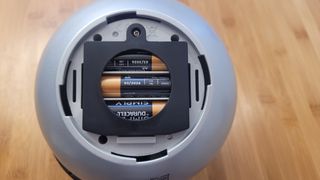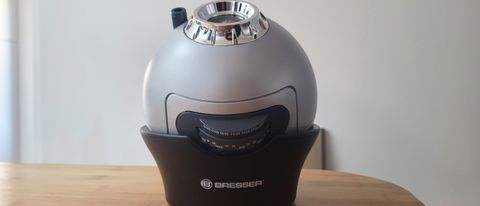Space Verdict
The Bresser Junior Astro Planetarium Deluxe has less functionality than its National Geographic competitor. It has a time and date selector, a shooting star function and a sleep timer, and it ships with two disks. Still, we'd probably spend a little extra to get the National Geographic Astro Planetarium for the ability to use mains power and for the inbuilt speaker.
Pros
- +
Projections true to chosen time and date
- +
Five-year warranty
- +
Intuitive, fuss-free operation
Cons
- -
Dated packaging
- -
No speaker, unlike its closest rival
- -
The motor is quite noisy
Why you can trust Space.com
The Bresser Junior Astro Planetarium Deluxe star projector is a home planetarium designed to engage children and help them find enjoyment in exploring the night sky from the comfort of their homes.
Size: 1550 x 1550 x 1910 mm
Bulb Type: White LED
Rotation: Yes
Sleep timer: Yes 30, 60 or 120 minutes
Speaker: None
Projection Surface: 1.6 x 2.1 m
Featuring in our best star projectors buying guide, the device projects a realistic starry sky onto any flat surface up to three meters away. The Astro Planetarium Deluxe is an excellent learning tool for kids interested in astronomy and the night sky and could also double as a scientific night light.
Bresser also makes the National Geographic Astro Planetarium Star Projector. Hence, we're interested to see how this one stacks up against the aforementioned model which we gave four stars out of five. Why buy one over the other? What are the differences? Without further ado, let's take a closer look.
Bresser Junior Astro Planetarium Deluxe star projector review:
Bresser Junior Astro Planetarium Deluxe: Design

- Two disks included
- Dated packaging could do with improvement
- A perfect gift for a young space lover
When buying a product for a child or giving one as a gift, the packaging is important. To be fair, the packaging isn't awful, but the chosen color scheme, image, and array of font shapes and sizes make it appear pretty dated and 'uncool'. That said, we never judge a book by its cover so let's consider the planetarium itself.
It can be likened to the design of the National Geographic Astro Planetarium in that it is a sphere that sits on a stand and so can be turned to face almost any angle you would want it to. It isn't limited to only moving vertically like the more expensive Sega Toys Homestar Flux.
There are six big, tactile buttons on the front to power on and off, control the speed of rotation, open the disk tray, activate the 'shooting star' feature and set the sleep timer. Like the National Geographic Astro Planetarium, there is a wheel to turn to select the night sky you want to see according to date and time. Little tabs in the disk tray guide you to insert the disk in the correct position.
It is black and silver, less garish than the bright yellow of the National Geographic Astro planetarium, but not as sleek in design as the powdered black matte finish of the Sega Toys Homestar Flux which would appeal more to more mature users. It is lightweight and plastic and probably wouldn't survive anything more than a small bump.
Bresser Junior Astro Planetarium Deluxe: Performance

- The motor is quite noisy
- Images are bright and clear
- The date and time feature works well
The Bresser Junior Astro Planetarium performs in much the same way as the National Geographic Astro Planetarium in terms of brightness and clarity of the projection, we expect they probably use the same components, given that Bresser manufactures both. The focuser works well. It's easy to turn and it's simple enough to bring the image of stars and constellations into focus from as far away as 3m from the projection surface.
As with the National Geographic model, the motor that rotates the disks clockwise or anti-clockwise is quite noisy, especially when turned up to top speed. While it isn't a particularly offensive noise, some might find it irritating, especially if using the planetarium to get to sleep.
The 'shooting star' feature shoots in the same direction every time and with the same interval between each movement. To improve upon this we'd like to see some variation in direction and interval time to make things a little more unpredictable, thereby mimicking real shooting stars.
Bresser Junior Astro Planetarium Deluxe: Functionality

- Powered by 3 x AA batteries (no mains powered option)
- Can be positioned in any direction
- No speaker functionality
Unlike the National Geographic projector, there is no option to play sounds or music straight out of the device to mask the sound of the motor or add to the ambience while 'stargazing'. Still, nothing stops you from playing music from an alternative speaker to hide the motor's noisy whir.
The Bresser Junior Astro Planetarium is powered by three AA batteries (included). Unlike the National Geographic Astro Planetarium, there is no option to power by 5V DC. The LED bulb is energy efficient, so although the batteries will last a long time, it's worth keeping some spare or investing in rechargeable ones. Of course, you also have the sleep timer, which can be set to turn off after 30, 60 or 120 minutes, so power isn't wasted if you accidentally leave it on or fall asleep if you're using it as a night light.

The Bresser Junior Astro Planetarium comes with both customer support and a two-year guarantee, extended to five years when you register the product online. This gives extra peace of mind as you can be assured you're covered if there are any issues or functionality problems.
Should I buy the Bresser Junior Astro Planetarium Deluxe?
The sole function of this planetarium is to project the included disks onto the ceiling according to the chosen time and date. It doesn't have speakers, an app, a remote, color LEDs or in-built radio, so in that regard, it is most similar to the Sega Toys Home Star Flux, which costs a lot more.
If that is all the functionality you are looking for, you don't want to purchase additional disks and you aren't fussy about the extra level of image detail the Home Star Flux displays, it makes sense to go for this Bresser model.
For only a small jump in price, the integrated speaker might be enough to draw you to the National Geographic Astro Planetarium instead. Users may also prefer the option to plug it into the mains rather than having to rely on batteries, especially if using for longer periods or operating daily.
If the Bresser Junior Astro Planetarium Deluxe isn't for you:
As mentioned throughout this review, the Bresser Junior Astro Planetarium can be most likened to the Sega Toys Homestar Flux and the National Geographic Astro Planetarium (the latter also being manufactured by Bresser). All three take imaging disks and project them onto a wall or ceiling, giving clear and bright images of celestial objects.
The Sega Homestar Flux disks have much more detail, and more disks are available to purchase that fit this model; nevertheless, that device is almost twice the price. You have to weigh up whether the additional cost is worth the extra detail and the more superior finish compared to the Bresser.
The National Geographic Astro Planetarium has more functionality. It has an in-built radio and can function as a speaker (using the included 3.5mm audio cable) to play music from your phone, and it sits at a similar price point. If we were buying a home planetarium as a gift for someone for their birthday or special occasion, we would gravitate towards the National Geographic Astro Planetarium.
If you're looking for something to light up a space lover's bedroom with gorgeous patterns and colors for younger users, we'd recommend the Astronaut Starry Sky projector. The BlissLights Sky Lite 2.0 or the Encalife Ambience Star Projector would be on our shopping list for older users.
For instruments that will benefit a real life star gazing experience for young budding astronomers, we have guides on the best telescopes for kids and the best binoculars for kids to enhance their sky-watching enjoyment.
Join our Space Forums to keep talking space on the latest missions, night sky and more! And if you have a news tip, correction or comment, let us know at: community@space.com.

Tantse Walter is a photographer and adventurer that's spent seven years facilitating global adventurous expeditions. She loves getting into the nitty-gritty of sourcing and planning trips. Whether that be for astrophotography location scouting, or just for the love of exploration. Tantse enjoys taking creative, bright and bold photos of people, places, animals and the night sky. Tantse’s photos have been purchased by notable companies such as Ford and Cross Country Trains as well as an upcoming book about the songs, rituals and musical history of Capoeira.

